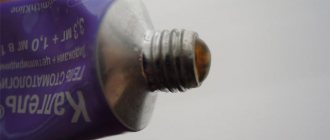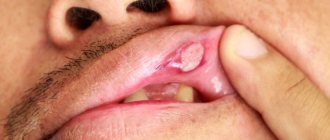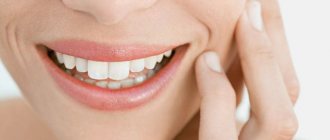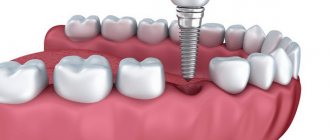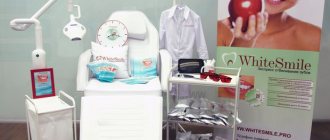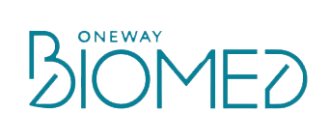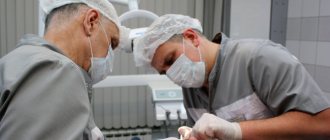Indications for use
The drug is recommended for use in the following cases:
- Gingivitis or periodontitis (acute or chronic form)
- Post-extraction alveolitis
- Stomatitis (aphthous type)
- Acute course of Vincent's gingivitis, accompanied by ulcerative-necrotic changes
- Periodontal disease, which occurs together with gingivitis
- Inflammation of the oral mucosa caused by wearing a denture
- Cheilitis
- Periodontal abscess or periodontitis (complex treatment).
Contraindications
The drug is recommended for use in the following cases:
- Gingivitis or periodontitis (acute or chronic form)
- Post-extraction alveolitis
- Stomatitis (aphthous type)
- Acute course of Vincent's gingivitis, accompanied by ulcerative-necrotic changes
- Periodontal disease, which occurs together with gingivitis
- Inflammation of the oral mucosa caused by wearing a denture
- Cheilitis
- Periodontal abscess or periodontitis (complex treatment).
Denta gel is not prescribed for use in the following cases:
- Excessive sensitivity to drug components and nitroimidazole derivatives
- Children's age (up to 14 years).
If dental diseases are accompanied by increased activity of pathogenic flora in the oral cavity, antibacterial therapy is necessary. Antibiotics for periodontal disease in adults are an integral part of an integrated approach to the problem. However, their use should not be the result of superficial self-medication.
If the disease progresses rapidly, gum inflammation leads to partial or complete loss of teeth.
To prevent this from happening, together with the dentist it is necessary to determine the etiology of the pathological process and study the extent of bone damage using an x-ray.
If the clinical picture is advanced, the specialist recommends treatment of periodontal disease with antibiotics, an integrated approach to the emerging health problem. Additional indications for antibiotic therapy are as follows:
- dental mobility;
- increased symptoms of periodontal disease;
- obvious inflammatory processes in the gums.
To treat periodontal disease with antibiotics, doctors recommend fourth-generation antibacterial agents with a systemic effect on a weakened organism. On the one hand, this is a positive point, since a mild and safe effect is concentrated on the source of pathology, on the other hand, side effects can spread to internal organs and systems.
Antibiotics for periodontal disease should be prescribed by a dentist, and the individual daily dosage must be clearly specified. The following medications in combination with Chlorhexidine have proven themselves well in this direction:
- Doxycycline;
- Metronidazole.
If a complicated clinical picture occurs, doctors do not rule out immediate surgical intervention.
To avoid surgery, you will have to undergo another course of antibiotics with a higher concentration of synthetic components.
In this way, you can quickly destroy a group of harmful bacteria, speed up the period of remission and achieve final recovery. Antibiotics with enhanced effects on the focus of pathology are presented below:
- Rondomycin;
- Ericicline;
- Azithromycin;
- Sumamed.
Medicines with antibacterial action are intended not only for external use (to smear sore gums), but are also intended for oral administration, i.e. through the mouth.
In this way, synthetic components reach the systemic bloodstream and provide a wide spectrum of action in the affected body.
Below are representatives of one pharmacological group that rapidly destroy pathogenic flora, and should only be taken orally.
If your doctor has prescribed this medication, the treatment will be most effective.
This is explained by the wide spectrum of action of synthetic components, the destruction of many types of pathogenic microorganisms.
Trichopolum is intended for oral administration, and daily doses are individually determined by the attending physician. From the detailed instructions for the drug you can read the following useful information:
- It is advisable to take the tablets during meals or after, without disturbing the integrity, with a sufficient amount of water.
- A single dose of this antibiotic is 1 pill, a daily dose is no more than 3 pills, but one at a time.
- The duration of antibacterial therapy for periodontal disease is no more than 5-7 days. If there is no positive dynamics, the specialist prescribes another treatment.
- There are contraindications, including hypersensitivity to the active components, damage to the central nervous system and kidneys, periods of pregnancy and lactation.
- The daily dose is calculated based on the age and weight of the clinical patient, but an overdose is dangerous for the digestive organs and the life of the patient.
- The risk of side effects is eliminated, and there are drug interactions, which is especially important when choosing a comprehensive treatment for periodontal disease.
- If the antibiotic turns out to be ineffective, you can always replace it with an analogue and continue treatment of periodontal disease.
These capsules also have a stable and long-lasting antibacterial effect. The medicine has an affordable price and belongs to tetracyclines.
You need to take the tablets up to 3 times a day after each meal, and swallow the medicine without chewing. Do not violate the dosage, and additional information on the topic is collected in detailed instructions.
Individual characteristics and mechanism of action are as follows:
- Before prescribing this antibiotic for periodontal disease, it is necessary to find out the main cause of the progressive inflammatory process.
- Such antibiotics in dentistry for inflammation help not only relieve intense symptoms, but also completely cleanse the body of increased activity of microorganisms.
- The drug is not allowed to be used for problems with the liver, central nervous system and kidneys, in case of lactose intolerance, during pregnancy and lactation, and in childhood.
- In case of overdose, the side effects only intensify, and the treatment of the clinical patient is symptomatic, aimed at suppressing anxiety symptoms.
- The antibiotic should not be combined with certain medications; there is a drug interaction between several pharmacological groups.
- The first side effects do not affect the gums, but the functionality of the nervous system. More often, the patient is bothered by migraine attacks, confusion, and ringing in the ears.
- If the liver and kidneys are dysfunctional, the dose of antibiotic for periodontal disease is halved, and the patient must be closely monitored.
This is a broad-spectrum drug with a bactericidal effect. The affordable price attracts all patients with the problem of painful gums, but certain health complications may arise during the treatment of periodontal disease. To achieve an anti-inflammatory effect, you must comply with the provisions prescribed below, excerpts from detailed instructions. So:
- Do not take two antibiotics at once in the complex treatment of periodontal disease, otherwise you can provoke an overdose in the body. If one medication does not ensure the destruction of pathogenic flora, you can replace it with a stronger analogue.
- Anti-inflammatory ointments and gels can enhance the effect of Lincomycin, but such medications for external use must be discussed with your dentist in advance.
- A single dose of antibiotic for periodontal disease is 500 mg. It must be taken 3-4 times a day, on average, for 2 weeks. If it still doesn’t help, it’s time to make some adjustments to the existing treatment regimen together with your doctor.
We invite you to read: What is granulation in dentistry?
Drug methods for solving dental problems are supplemented with medications for external use. These are special ointments and gels with anti-inflammatory and antiseptic effects that provide accelerated regeneration of damaged tissues. The following medicinal ointments are especially effective in a given direction at affordable prices:
- Elugel;
- Elgifluor;
- Metrogil Denta;
- Troxevasin;
- heparin ointment.
The cost of home treatment is affordable, and the antibiotics suggested above for periodontal disease are considered a budget option. For example, a Gentamicin solution with an antibacterial effect costs no more than 50 rubles, and the price of Cifran tablets is 50-70 rubles.
Medicines Doxycycline and Metronidazole will cost the buyer 100-150 rubles, but ointments, for example Troxevasin, are somewhat more expensive (about 200 rubles).
In any case, home treatment of periodontal disease is a budget option; significant waste is observed even with surgical intervention by the dentist.
This is a combined antimicrobial agent used in dentistry. Efficiency is ensured by the presence of two components - metronidazole and chlorhexidine. Metronidazole is a 5-nitroimidazole. The mechanism of its action is due to the ability to interact with deoxyribonucleic acid (DNA) of microbial cells.
In this case, the production of nucleic acids is inhibited and the death of bacteria occurs. Active against protozoa: Entamoeba histolytica, Trichomonas vaginalis, Giardia lamblia, as well as facultative anaerobes Bacteroides spp.
(Bacteroides ovatus, Bacteroides fragilis, Bacteroides distasonis, Bacteroides thetaiotaomіcron, Bacteroides vulgaris), Prevotella spp. (Prevotella buccae, Prevotella bivia, Prevotella disiens), Fusobacterium spp., Veіllonella spp., some gram-positive obligate (Clostrіdium spp.), facultative (Eubacterium spp., Peptococcus spp.
, Peptostreptococcus spp., Mobiluncus spp.) anaerobes, facultative aerobe Gardnerella vaginalis. Aerobes are insensitive to metronidazole, but in the presence of mixed flora (anaerobes, aerobes) it acts synergistically with antibiotics. Chlorhexidine is a bactericidal (kills bacteria) antiseptic.
Active against a wide range of vegetative forms of gram-negative and gram-positive microorganisms, as well as yeast, dermatophytes and lipophilic viruses.
Active ingredients: metronidazole (10 mg), chlorhexidine (0.5 mg).
Metronidazole Denta is available in the form of a gel for gums.
Indications
– for acute/chronic gingivitis (edematous, atrophic, hyperplastic);
– with acute ulcerative-necrotic gingivitis of Vincent;
– for aphthous stomatitis;
– for periodontitis, periodontal abscess.
Contraindications
– if you are allergic to metronidazole or other nitroimidazole derivatives;
– if you are allergic to chlorhexidine;
– in case of intolerance to auxiliary components;
– children under 14 years of age.
This medicine is contraindicated during pregnancy.
The active components can pass into breast milk, so breastfeeding should be discontinued during treatment. Feeding can be resumed no earlier than 48 hours after stopping the use of this medicine.
Medicinal properties
The complex of components Metronidazole + Chlorhexidine has an antibacterial and anti-inflammatory effect, which helps to quickly eliminate pain in the oral cavity.
Metranidazole has an antibacterial effect and has a detrimental effect on anaerobic microorganisms that cause periodontal diseases.
Chlorhexidine not only neutralizes pathogenic flora, but also has antiseptic properties. The activity of chlorhexidine extends to gram-positive and gram-negative (anaerobes and aerobes) microorganisms. Acid-fast bacteria are not sensitive to this component. The use of chlorhexidine does not affect the activity of lactobacilli.
Metranidazole is practically not absorbed when used topically.
Mode of application
Metronidazole gel is recommended to be applied to the surface of the gums twice a day. Next 15 min. After using the drug, you should not rinse your mouth or eat food, as this will reduce the therapeutic effectiveness of the drug. The duration of treatment is from 7 to 10 days.
For stomatitis, Metronidazole Denta must be applied to the affected area of the oral mucosa twice within 24 hours, treatment procedures should be carried out for 7-10 days.
For preventive purposes, Denta gel should be used together with toothpaste. The duration of preventive procedures is 2-4 weeks once or twice over 12 months.
Instructions for use of the drug Metronidazole gel during pregnancy and breastfeeding
It is not recommended to use the drug during pregnancy and breastfeeding. Prescription of the drug is possible in exceptional cases when the expected benefit to the mother significantly exceeds possible adverse reactions in the fetus.
Directions for use for gum inflammation
Do not rinse your mouth with Metronidazole in the form of an intravenous solution. Improper use of the medicine causes poisoning. Infectious and inflammatory gum diseases should be treated with oral tablets 250 mg or 500 mg, cream, gel. IVs are placed in hospitals. After using medications for external use, do not consume anything and do not rinse your mouth for at least 30 minutes.
Local treatment of gum inflammation with Metronidazole is carried out in two ways:
- Apply the gel to the inflamed area twice a day. The product is applied in a thin layer to the roots of the teeth. While it is distributed over the mucous membrane, the gums are massaged with a finger. Saliva must be spat out;
- They make applications. Grind one 500 mg tablet, dissolve the powder in Chlorhexidine (antiseptic solution). A gauze swab is moistened in the liquid and placed between the inflamed gum and lip, cheek.
Together with Amoxicillin or another antibiotic for gingivitis, Metronidazole is prescribed orally for people over 18 years of age. In monotherapy for gum inflammation, the dose for adults is calculated according to the scheme 7.5 mg/kg (but not more than 4 g per day), and for children – 5 mg/kg. The medicine must be taken three times a day. For children, an individual daily dosage is calculated.
Read also: Periodontitis causes
Precautionary measures
With topical use of an antibacterial agent, the concentration of active substances in the gum area is much higher than that observed with oral administration. Accordingly, local use of Metronidazole Denta is preferable; the risk of adverse reactions in this case is minimal.
It is necessary to avoid contact of the antibacterial agent with the mucous membrane of the eyes. Drinking alcohol during treatment with Metronidazole gel is extremely undesirable, as disulfiram-like reactions may occur.
Directions for use for gum inflammation
Do not rinse your mouth with Metronidazole in the form of an intravenous solution. Improper use of the medicine causes poisoning. Infectious and inflammatory gum diseases should be treated with oral tablets 250 mg or 500 mg, cream, gel. IVs are placed in hospitals. After using medications for external use, do not consume anything and do not rinse your mouth for at least 30 minutes.
Local treatment of gum inflammation with Metronidazole is carried out in two ways:
- Apply the gel to the inflamed area twice a day. The product is applied in a thin layer to the roots of the teeth. While it is distributed over the mucous membrane, the gums are massaged with a finger. Saliva must be spat out;
- They make applications. Grind one 500 mg tablet, dissolve the powder in Chlorhexidine (antiseptic solution). A gauze swab is moistened in the liquid and placed between the inflamed gum and lip, cheek.
Together with Amoxicillin or another antibiotic for gingivitis, Metronidazole is prescribed orally for people over 18 years of age. In monotherapy for gum inflammation, the dose for adults is calculated according to the scheme 7.5 mg/kg (but not more than 4 g per day), and for children – 5 mg/kg. The medicine must be taken three times a day. For children, an individual daily dosage is calculated.
Cross-drug interactions
Using Denta gel in therapeutic doses, systemic interaction with other drugs was not observed.
When using the drug Metronidazole with Warfarin and indirect anticoagulants, the effect on the body of the latter may be enhanced, and the thrombosed time increases.
Using Denta gel together with Disulfiram increases the toxic effects of drugs, and the development of neurological disorders is possible.
Phenobarbital together with Phytin can reduce the antimicrobial effect of Metronidazole, which is associated with accelerated metabolism of the latter.
Cimetidine can inhibit the metabolism of metronidazole-based drugs, thereby increasing its concentration in the blood serum.
Metronidazole in action, how to use
Active against most obligate (spore-forming and non-spore-forming) gram-negative and gram-positive anaerobes (especially bacteroides, fusobacteria) and causative agents of protozoal infections (Trichomonas, amoebas and lamblia).
In the microbial cell, under the influence of reductases, the nitro group of metronidazole, which is an electron acceptor, is restored, and respiratory processes are disrupted.
The active metabolite, interacting with DNA, causes its degradation and disrupts the processes of DNA replication and transcription.
Metronidazole for intravenous administration is not recommended to be mixed with other drugs.
1 For all methods of using metronidazole.
2 Metronidazole should not be prescribed to patients who have taken disulfiram within the past two weeks.
Metronidazole is a drug that has an antiprotozoal effect and has antimicrobial activity. This medicine is included in the list of drugs that are recognized by WHO as the most important.
The remedy was discovered by French pharmacists in the middle of the last century. The drug became the first in the group of nitroimidazoles to be successfully used for the treatment of trichomoniasis.
Metronidazole has a detrimental effect on bacterial flora. This effect was discovered later than the product increased its popularity.
The product blocks the formation of nucleic acids, so the formation of a population of microorganisms stops, so they die over time. The medicine acts on pathogenic aerobic agents, that is, microorganisms that do not need oxygen to live.
Periodontitis, like most dental diseases, can be treated without surgery if it is detected in the early stages. At the first signs of the disease, taking antibacterial drugs is effective.
We suggest you read: Skin rashes during teething
Important! In order to completely cure periodontitis, avoid complications and transition of the disease to the chronic stage, you need to undergo a course of treatment prescribed by your doctor.
Metronidazole has a wide spectrum of action and is highly effective as an antimicrobial and antibacterial drug for periodontitis. Dentists claim that the product makes it possible to destroy the maximum number of pathogenic bacteria.
Dosage
Metronidazole for periodontitis is recommended to be taken orally, 1 tablet (0.25 g) after meals every 8 hours. The recovery course includes no more than 5-7 days.
Photo 1. Packaging of the antimicrobial and antiprotozoal drug Metronidazole in the form of tablets of 250 mg, .
Using Denta gel in therapeutic doses, systemic interaction with other drugs was not observed.
When using the drug Metronidazole with Warfarin and indirect anticoagulants, the effect on the body of the latter may be enhanced, and the thrombosed time increases.
Using Denta gel together with Disulfiram increases the toxic effects of drugs, and the development of neurological disorders is possible.
Phenobarbital together with Phytin can reduce the antimicrobial effect of Metronidazole, which is associated with accelerated metabolism of the latter.
Cimetidine can inhibit the metabolism of metronidazole-based drugs, thereby increasing its concentration in the blood serum.
Analogs
Metrogyl Denta gel
Price from 116 to 340 rubles.
Metrogyl Denta is a complete analogue of Metronidazole gel, which indicates the same characteristics and properties of the medications. The drug for local use is available in tubes containing 5 g, 10 g, 20 g of gel-like substance.
Pros:
- Can be used to treat children from the age of six
- Available without a prescription
- Easy to use, highly effective.
Minuses:
- Not prescribed in the 1st trimester of pregnancy
- During use of the gel, local adverse reactions are possible.
Metronidazole in dentistry
Miramistin
- a local antiseptic drug, which also belongs to chlorine derivatives. Possesses the properties of a cationic detergent. Interacting with the membranes of microorganisms, it increases their permeability and causes cytolysis. Miramistin is active against a wide range of gram-positive and gram-negative microorganisms, both aerobic and anaerobic, as well as spirochetes, intracellular pathogens, and viruses. The drug stimulates the activity of immunocompetent cells, promotes tissue repair and regeneration. An important property of the drug is its low absorption capacity, due to which it practically does not enter the bloodstream and has only a local effect.
Betadine
(iodine-based solution) has been successfully used for subgingival irrigation. Contains polyvinylpyrrolidone. which is an iodophor, due to which active iodine is gradually released upon contact with the skin or mucous membranes. The antiseptic is active against bacteria, fungi, viruses and protozoa, especially in the form of irrigation, when using ultrasonic equipment. The iodine-containing drug Vocadine is similar to betadine in its properties and nature of use.
Among antiseptic drugs
local action, which are used in dentistry, it should be noted strepete, an antiseptic combination drug, active against a wide range of gram-positive and gram-negative microorganisms and fungi; ambazon - has a bacteriostatic effect on coccal microflora (the drug is intended for the treatment and prevention of acute infectious and inflammatory periodontal diseases, mainly gingivitis; it also serves for the prevention of infectious and inflammatory diseases after tooth extraction). Biclotymol has a similar effect.
In addition to antiseptics
Antibacterial drugs containing metronidazole are widely used locally (not only systemically). Metronidazole (a nitroimidazole derivative, [1-oxyethyl)-2-methyl-5-nitroimidazole]) has antiprotozoal and antibacterial (antianaerobic) properties. It is used in various dosage forms, different doses of the active substance and methods of treatment are used.
Long-term antimicrobial and anti-inflammatory effect
, strict dosing of the drug and its “work” directly in the lesion is ensured by the “Diplen-dent” film with metronidazole.
Gels are also offered
and
creams
containing metronidazole (metrogyl, metrogil-denta, metronidazole, rozamet). Local complex use of gels with chlorhexidine and metronidazole has proven to be especially effective in the treatment of gingivitis and periodontitis.
One of these gels
is Metrogyl-denta from Unique Pharmaceutical Laboratories. It contains two active components in stable concentrations: metronidazole and chlorhexidine benzoate.
It should be noted that such mixtures
in our country have been used for a long time, they were prepared ex tempore. Their disadvantages included a very bitter taste and insufficient dosage accuracy. However, their high efficiency and virtual lack of alternatives have ensured their continued preservation in the arsenal of specialists up to the present day.
The obvious advantages of Metrogil-dent gel
, specially intended for dental practice, are primarily its organoleptic properties - a pleasant, refreshing taste. Its water solubility does not impede the outflow of exudate from the PC, and since the gel has high fluidity, it fills the PC as much as possible. It is convenient to apply the gel into the periodontal sulcus (for gingivitis) or PC (for periodontitis) using a syringe with a blunt needle. The duration of stay of metrogildent in pockets should be differentiated depending on the clinical condition of the periodontium.
Relevance of Metronidazole use
The drug Metronidazole is a highly active antimicrobial drug with a wide spectrum of activity for the treatment of diseases caused by anaerobic pathogenic bacteria, as well as some infectious pathologies caused by protozoa (giardiasis, trichomoniasis, etc.). There are indications for treatment with Metronidazole for abdominal pathologies, women's diseases, dentistry and other areas.
In addition, it is used not only as a product with antibacterial properties. It is also in demand as an auxiliary medicine that improves the effectiveness of radiation treatment. It is used as an effective radiosensitizing agent. Having the ability to easily penetrate and invade the tissues and cells of the human body, it enters the tumor, sensitizing its cells, as a result of which their sensitivity to radiation treatment increases.
Application in gynecology
Wide indications for the use of Metronidazole in gynecology.
- It is recommended for the treatment of endometritis that develops after childbirth. It is often taken in parallel with aminoglycosides. For severe, advanced endometritis, as well as for the treatment of infected abortion, Metronidazole regimens with fluoroquinolones are recommended.
- The drug is also relevant in treatment regimens for postpartum septic complications, with the formation of peritonitis that develops after cesarean section.
- Bacterial vaginosis is also a direct indication for Metronidazole therapy. Their cause is a violation of the physiological balance between representatives of the normal and opportunistic microflora of the vagina. This can happen in any pathological condition in the body that leads to a decrease in immunity. As a result, the volume of opportunistic microflora increases while the normal one decreases. For example, the reproduction and increase in the number of opportunistic Gardnerella spp. is diagnosed. A decrease in its amount after antibacterial therapy indicates normalization of the general microflora of the vagina.
Metronidazole is taken according to indications in gynecology, both in tablets and intravenously, as well as in suppositories for vaginal use.
Treatment of infections caused by protozoa
Metronidazole tablets are not effective in treating many worms. They do not work against worms such as roundworms, tapeworms, pinworms and others. However, Metronidazole tablets show high effectiveness in the fight against protozoan worms, that is, amebiasis, trichomoniasis, giardiasis, balantidiasis.
As a rule, when treating protozoa and worms, tablets and capsules are taken. Indications for intravenous administration of Metronidazole against single-celled worms and worms occur extremely rarely, only in severe conditions.
When infected with trichomoniasis, Metronidazole is indicated both for the treatment and for the prevention of infection. There are several schemes for getting rid of protozoa with this drug. To date, it remains the most popular. However, in almost 5% of all patients it was found that Trichomonas are not sensitive to this drug.
For amebiasis, Metronidazole tablets are effectively used in treatment regimens for adult protozoa, but treatment with this drug is ineffective if cyst carriage occurs.
It treats balantidiasis as part of complex therapy.
For chlamydia, Metronidazole tablets can be used in combination with other drugs. Metronidazole is not active against chlamydia as such, but it can be prescribed for chlamydia in order to suppress the accompanying flora, which can be activated when its balance is disturbed, provoked by protozoa.
Useless if a direct effect on chlamydia and worms is necessary, Metronidazole for giardiasis is the main component of complex treatment.
The use of trichopolum in the treatment of gums
Have you been fighting against PARASITES for many years without success?
Head of the Institute: “You will be amazed at how easy it is to get rid of parasites just by taking it every day.
Many antibiotics, successfully used in the treatment of a number of serious diseases, are powerless against simple microorganisms. To combat protozoal diseases, special drugs are required that act specifically on this group of microorganisms. These drugs include metronidazole. This synthetic antibiotic is a chemical modification of azomycin, produced by bacteria of the genus Streptomycetes. This medicine is widely known under the trade name "Trichopol", which is patented by the Polish.
Our readers successfully use Intoxic to get rid of parasites. Seeing how popular this product is, we decided to bring it to your attention. Read more here...
This drug was originally developed as a cure for trichomoniasis, but it was accidentally discovered that it can also act on bacteria. And that in the treatment of inflammatory processes of the gums, complications after tooth extraction and other problems of the oral cavity, Trichopolum can also be used.
Indications for use of trichopolum
Serious diseases can be caused not only by viruses and bacteria, but also by protozoa. Among the diseases caused by the latter is one of the most dangerous diseases - malaria, which claims hundreds of thousands of lives per year. Protozoan microorganisms also cause dangerous diseases such as:
- amoebiasis;
- leishmaniasis;
- trypanosomiasis;
- giardiasis;
- balantidiasis and others.
Among the diseases caused by protozoa is such a very common phenomenon as trichomoniasis, which is the most common among both diseases of the genitourinary organs and among infections and infestations transmitted through sexual contact.
Initially, Trichopolum was used for trichomoniasis. Subsequently, the range of its applications significantly
expanded. This drug can act on the following protozoan microorganisms:
- Trichomonas, causing trichomoniasis.
- Amoebas are the causative agents of amebic dysentery.
- Isospora.
- Giardia.
In addition, this antibiotic also acts on a number of bacteria, such as:
- Gardnerella, which causes gardnerellosis.
- Bacteroides, which are causative agents of various diseases, from chronic runny nose to necrotizing pneumonia.
- Fusobacteria, which can cause purulent and gangrenous processes in people with weakened immune systems.
- Veillonella, the accumulation of which on teeth leads to periodontitis.
- Prevotella, which causes inflammation of the gums.
- Clostridia are the causative agents of tetanus and gas gangrene.
- Peptococci involved in the development of inflammatory processes in the oral cavity, in particular, those that arise as complications after tooth extraction.
Thus, Trichopolum can be used for trichomoniasis, gardnerellosis and other diseases caused by the above microorganisms. In addition, metronidazole destroys Helicobacter pylory, and therefore Trichopolum can also be prescribed when the stomach hurts due to gastritis or peptic ulcer. However, if your stomach hurts, treatment with metronidazole is advisable only if the disease is caused by these bacteria.
Metronidazole is used both for independent diseases and for various secondary pathologies, for example, in dentistry, when it is necessary to treat complications after tooth extraction.
Metronidazole affects not only
unicellular microorganisms, but also against multicellular parasites such as demodex mites. Therefore, Trichopolum is also used for demodicosis. Numerous reviews indicate that such treatment gives positive results.
Trichopolum can be taken orally in tablet form. Injections of the drug are also prescribed. For trichomoniasis and gardnerellosis, the medicine can be used in the form of vaginal suppositories. The question of how to take Trichopolum for trichomoniasis, in the form of tablets or in the form of suppositories, is decided by the attending physician in relation to each specific case.
Is metronidazole used to treat thrush?
Among diseases of the female genital organs, thrush, which is caused by yeast-like fungi Candida, is very common. Therefore, many women have a question about whether trichopolum helps against candida. The answer here will be as follows.
Read also: Ointment for gums
Metronidazole has no effect on candida. Therefore, when treating candidiasis by itself, this drug not only will not help, but can even cause harm if used carelessly. Like any antibiotic, metronidazole disrupts the natural microflora and weakens the body's protective functions. Therefore, the use of this medicine in the treatment of candidiasis may aggravate the situation due to the intensification of reproduction of both the fungus itself and other microorganisms on which metronidazole has no effect.
Another thing is cases of mixed infection, when a disease caused by microbes sensitive to metronidozole develops against the background of candidiasis. Trichopolum is widely used for gardnerella, therefore in such cases this drug is prescribed, but this will be the treatment of gardnerella with trichopolum, but not candidiasis as such. The same can be said about the case when thrush is a concomitant disease with trichomoniasis.
Metronidazole preparations can be used for candidiasis and for prophylactic purposes - to prevent the proliferation of pathogenic microorganisms. However, in any case, trichopolum should be taken with caution for candidiasis and only as prescribed by a doctor.
How does metronidazole work?
The action of this antibiotic is to suppress the synthesis of nucleic acids in the cells of bacteria and protozoan microorganisms. As a result, the death of microbes occurs.
Once in the human body, metronidazole is well absorbed in the gastrointestinal tract, after which it spreads throughout almost the entire body. The liver metabolizes the antibiotic, resulting in the formation of its derivative, which has a similar effect on microorganisms. The drug is removed from the body, mainly through urine. Some of it is excreted along with feces.
In addition to the therapeutic effect, metronidazole, like other antibiotics, can also have a negative effect on the body. Incorrect use of the drug, exceeding its dosage, or hypersensitivity to it can cause the following consequences:
- Allergic skin reactions in the form of itching and rashes.
- Neurological reactions in the form of sleep disorders, depression, increased excitability, headaches and dizziness, convulsions, fainting.
- Reactions of the digestive system, such as loss of appetite, diarrhea or, on the contrary, constipation, abdominal pain, metallic taste in the mouth, distortion of taste.
- Problems of the hematopoietic system.
In addition, thrombophlebitis may occur with intravenous injections of the drug.
When should you not take metronidazole medications?
Medicines containing metronidazole should not be used if you are hypersensitive to this antibiotic.
Treatment with this drug is also contraindicated in pregnant women during the first trimester. In subsequent trimesters, treatment with Trichopolum is permissible, but only in cases where the possible benefit to the woman outweighs the risk to which the fetus is exposed in this case.
If a nursing woman needs to take Trichopolum, she should stop breastfeeding during the course of treatment.
If a woman begins to menstruate while taking the drug in the form of vaginal suppositories, the course of treatment is suspended.
How is Trichopolum used for toothache?
Metronidazole, initially used as a treatment for trichomoniasis, accidentally found use in dentistry when a patient treated for trichomoniasis had inflammation of the gums. Nowadays this drug is widely used to treat inflammatory processes in the oral cavity. In dentistry, in the treatment of diseases of the gums and teeth, this antibiotic can be used in the form of tablets. In addition, there are ointments for gums containing the drug.
In dentistry, trichopolum is used to relieve local inflammation during gingivitis. Signs of this disease include pain,
redness and bleeding of the gums, bad breath. However, in this case, you cannot self-medicate, since this disease often, in addition to drug treatment, also requires surgical procedures - cleaning the gums from ulcers, removing its overgrown parts and dental plaque. Such measures become necessary in the later stages of the disease, the onset of which is indicated by the appearance of an odor.
For periodontitis, the main treatment is surgical and consists of removing tartar and gum pockets. Against the background of these procedures, metronidazole may be prescribed as an anti-inflammatory agent.
The use of trichopolum after tooth extraction
After tooth extraction, Trichopolum is used primarily in case of complications. Sometimes after this operation inflammatory processes occur. This usually occurs either after an unsuccessful tooth extraction, as a result of which the wall of the socket is damaged, or when the patient’s immunity is weakened, when the wound left after the operation does not heal and hurts for a long time.
Read also: Causes of periodontitis in adults
Often the cause of complications after tooth extraction is the patient’s neglect of the doctor’s instructions regarding personal postoperative procedures, such as rinsing the mouth. If, after tooth extraction, inflammatory processes in the oral cavity begin, the doctor may prescribe treatment with antibiotics, including Trichopolum.
How is Trichopolum used for bad breath?
The appearance of bad breath is a common phenomenon and can be caused by various reasons, from poor personal hygiene to various diseases of the digestive system, in particular gastritis. If the cause of bad breath is gingivitis or periodontitis, then to remove it, treatment of the corresponding disease is required, for which trichopolum can be prescribed.
If the cause of bad breath is gastritis, then treatment of this disease is necessary, which can be done with the use of metronidazole.
If you experience bad breath, you should consult a doctor to determine the cause. The doctor will determine the exact cause of this odor and prescribe appropriate treatment. Using metronidazole or other antibiotics on your own to remove bad breath, relieve inflammation after tooth extraction, or for any other purpose means exposing yourself to considerable risk. After all, the cause of the smell can be not only bacterial infections, but also problems with the endocrine system or hormonal disorders. In such cases, the use of antibiotics can only cause harm.
Application in dentistry
Metronidazole is also used for dentistry. Tablets are prescribed as monotherapy or as a component of complex antibiotic therapy, for example, with Amoxicillin. They are widely used in the treatment of mixed (aerobic and anaerobic) infections in dentistry. For example, these drugs can be prescribed together or as monotherapy in dentistry for inflammatory and purulent periodontal lesions.
In surgical dentistry of the maxillofacial area, Metronidazole is also actively used as a treatment and prevention of postoperative complications as a drug with a wide spectrum of antimicrobial activity.
Prescription for preventive purposes
In some cases, the patient is indicated for prophylactic use of such drugs. Then antibiotics for dental treatment should be taken 1-3 days before the upcoming procedure.
Most often, such measures are necessary in case of a high risk of septic endocarditis. The group of such patients includes carriers of installed pacemakers, patients with artificial valves and those who suffer from heart failure, polyarthritis, endocarditis, etc. Patients with joint prostheses also join the above.
Prescribing antibiotics in these cases is essential due to the risk of tissue infection. This is especially true when performing dental procedures accompanied by bleeding.
Read also: How to take Ketanov for toothache
Even banal removal of tartar can lead to similar consequences. The result will be the entry of pathogenic microorganisms into the blood and the further development of an inflammatory disease.
The group of special patients in need of antibiotic therapy includes those suffering from chronic infections in the oral cavity and patients with weakened immune systems. The target group is also supplemented by patients with diabetes mellitus, rheumatoid arthritis, etc.
The selection of drugs in case of need for preventive antibiotic therapy is also carried out on an individual basis.
Treatment of peptic ulcers and other gastrointestinal pathologies
Metronidazole is one of the therapeutic drugs in the treatment of gastric and duodenal ulcers in order to get rid of one of its main culprits, H. pylori.
Treatment of these gastrointestinal pathologies always requires an integrated approach. Monotherapy with any antibiotic is not effective. There are several treatment regimens. The most effective is the complex of Metronidazole and Clarithromycin. Combinations of Metronidazole with macrolides or b-lactams (ampicillin) are also relevant. Proton pump inhibitors are required for all regimens.
Pseudomembranous colitis. Metronidazole is active against Clostridium difficile. Therefore, it is widely used in the treatment of pseudomembranous and necrotizing colitis. It works bactericidal.
Metronidazole is also successfully used topically: ointments, creams, gels. Indications for the use of such forms: purulent lesions on the skin, sluggish wounds.
